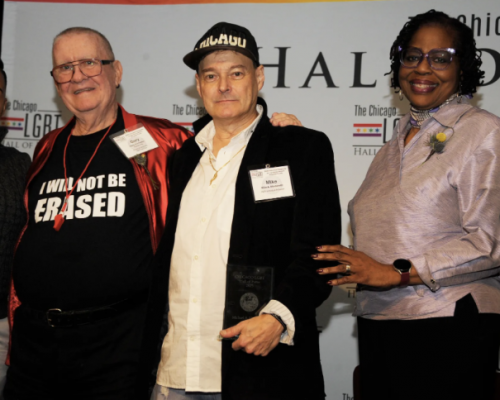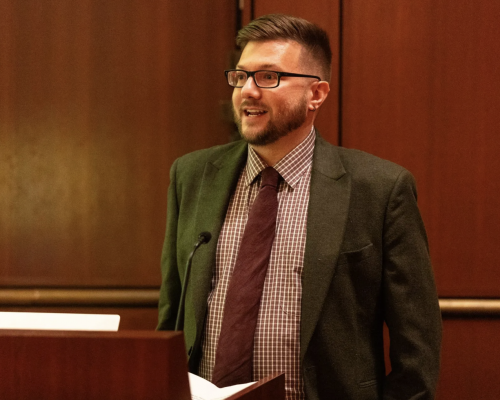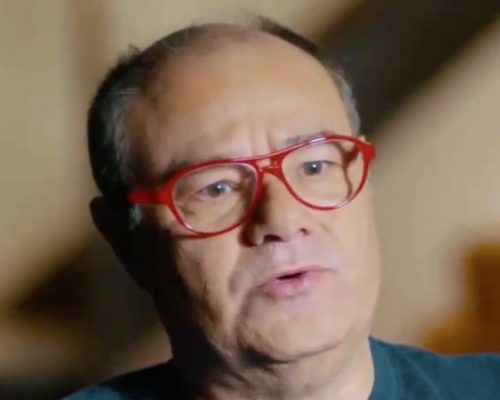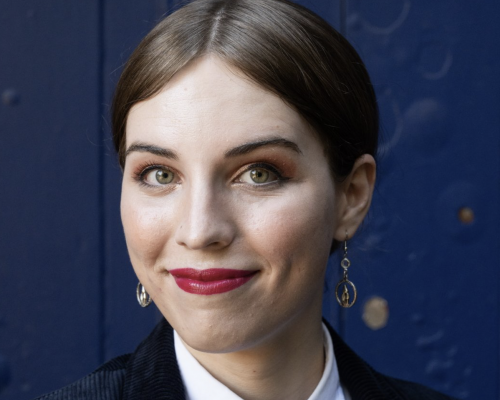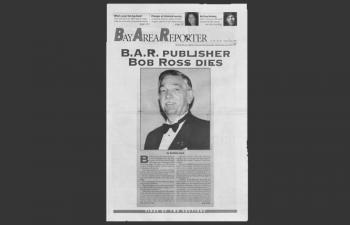
Once a bar rag, the B.A.R. now focuses on LGBTQ news
by John Ferrannini
(John Ferrannini is the assistant editor of the Bay Area Reporter. The following, reprinted with permission, is an edited version of a story that ran in the newspaper on April 1, 2021. The full piece is available at https://www.ebar.com/news/news/303476.)
Fifty years ago the gay bar — that foremost location for so much dating, friendships, political organizing, and times both fun and challenging — gave birth to the B.A.R., when the first copies of the Bay Area Reporter were set atop cigarette machines in San Francisco watering holes.
Since those early, heady days of what was then called the Gay Liberation Movement, the bar rag evolved to become the undisputed newspaper of record for the Bay Area’s LGBTQ community, distributing 20,000 paper copies each Thursday, and of course available 24/7 online.
According to Michael Yamashita, a gay man who has been the paper’s publisher since 2013, the paper has never missed an issue deadline — not even when threatened by the Loma Prieta earthquake in 1989.
Yamashita was in the paper’s offices — then at 395 Ninth Street, where writers and editors worked until a brief 2013 move downtown preceded the paper’s current address at 44 Gough Street — and was about to leave for the day.
“It was awful because we started to hear about fires in the Marina, the Bay Bridge collapsing, freeways pancaking, and that night most of the city had lost electricity,” Yamashita said. “The next day we were determined. Someone had electricity and so we went over there and started pasting up the paper. Thank goodness the press had electricity.”
Yamashita had started at the paper earlier that year, as an assistant editor under Ray O’Laughlin. The paper was headed by Bob Ross from its inception in 1971, when he’d founded it with Paul Bentley, until Ross’ death in 2003. (Ross later bought out Bentley.)
Nicole Murray Ramirez, a gay man who serves as a San Diego human rights commissioner and who co-chairs that city’s mayoral LGBTQ advisory body, said that he was excited to discover the B.A.R. in those days, when he’d travel to San Francisco occasionally from his then-home in Los Angeles.

“I picked up one of the first issues at a bar,” Murray Ramirez, who is a long-standing figure in both LGBTQ activism and the Imperial Court system, said. “[Ross] was a difficult guy, but his heart was in the right way. I thought he’d had a good chance to succeed Harvey [Milk], but [then-San Francisco Mayor] Dianne [Feinstein] decided against it because he was involved in the Imperial Court, so it was bad timing.”
A power at City Hall
Milk, who became one of the first out LGBTQ elected officials in the United States with his 1977 election to the San Francisco Board of Supervisors, had worked with Ross in enlisting LGBTQ bar owners to boycott Coors beer in 1973 as part of an alliance with the Teamsters union. He also served as the paper’s first political columnist, continuing to file his Milk Forum columns throughout 1978. His last column would appear in the November 22 issue that year, five days before he was assassinated along with then-mayor George Moscone inside City Hall that morning of November 27. Wayne Friday, who in the March 18,1976, issue of the B.A.R. had launched his own column called World of Wayne, which was renamed Politics & People a year later and often appeared next to Milk’s columns, would go on to become the paper’s lead political columnist and later its political editor.
Murray Ramirez, a mover and shaker in San Diego politics, said he was a devoted reader of Friday, who wrote the column for 35 years, preceding the current offering — assistant news editor Matthew S. Bajko’s Political Notebook in the Thursday paper and his companion Political Notes online column that appears most Mondays. Since 1974, Murray Ramirez has written his own column in various San Diego LGBTQ papers. It currently runs in the LGBTQ San Diego County News, of which he is the associate publisher.
“Your paper and the Washington Blade I would keep and reference,” Murray Ramirez told the B.A.R. “I would steal and, of course, I never gave you credit, being a queen. People would call me and say, ‘How did you get that?’ and I would say, ‘I have my sources’ — which was not a lie. People take the B.A.R. for granted.”
As the political power of the LGBTQ community grew, the power of the B.A.R.’s stories and Ross’ did, as well.
“What’s really important to note as the B.A.R. approaches its 50th anniversary is how it’s covered the A-Z of San Francisco politics, and the A-Z of LGBT politics in the Bay,” said Rebecca Prozan, a lesbian who worked for San Francisco Mayor Willie Brown, then-San Francisco District Attorney Kamala Harris’ first campaign, and former San Francisco District Attorney George Gascón. “At City Hall in the 1990s, the first thing you did was pick up a paper and find out what was happening in the community. It was a snapshot of the community at that time. Wayne Friday always had the insider tips in his political column.”
Friday died by suicide in 2016 after a long battle with Parkinson’s disease.
In October 1997, however, it was Cynthia Laird who had the scoop in a front-page story about how Joel Ventresca, a candidate for San Francisco treasurer, had fudged his credentials in his ballot statement and throughout the campaign.
His opponent, then-city Supervisor Susan Leal, a Latina lesbian who won the race, said that the paper advocated for the community.
“I felt the B.A.R. was part of my political life as a supervisor, as well as as treasurer, during those years,” she said. “The B.A.R. made a difference not only getting my word out but asking the tough questions so I knew I was listening to people in my community. Cynthia [Laird] or someone else would ask ‘what about this?’ and push me a little bit. It was visionary of Bob Ross. Mr. Ross was definitely a visionary.”
Leal went on to serve as general manager of the San Francisco Public Utilities Commission and is now a principal of Urban Water Works.
Some, however, felt that the B.A.R. took too conservative a tact. Cleve Jones, a gay man who has been a longtime community activist, said as much.
“I’ve been consistently frustrated by the positions on the editorial page about political issues,” Jones said. “Time and time again, the B.A.R. has opposed progressive legislation and candidates that I’ve supported.”
During the paper’s history, its endorsements have been all over the political map. Back in 1975, the paper threw its support behind progressive reformer George Moscone, then a state senator, for mayor; he would go on to win a close runoff race that December and usher in a number of pro-LGBTQ changes at City Hall. In November 1976, the paper withheld endorsing any presidential candidate due to neither of the major party candidates supporting gay rights, while in 1988 it went with civil rights leader Jesse Jackson in the June presidential primary.
The B.A.R. backed Milk’s various campaigns for elected office. Following his and Moscone’s assassinations in 1978, the paper routinely endorsed Milk’s successor gay Supervisor Harry Britt in his reelection campaigns and unsuccessful 1987 congressional bid, and Dianne Feinstein, who became interim mayor and won election to the position outright before going on to be elected a U.S. senator.
The paper’s endorsements have tended to favor incumbents, whether they be LGBTQ or straight, moderates or progressives. While some years favored moderates, in 2020 the paper endorsed a number of progressive supervisor candidates who won.
Those LGBTQ elected officials which the B.A.R.’s editorial page has supported noted how the paper has served as a touchstone for the community.
“I want to offer my congratulations to the B.A.R. as it celebrates its 50th anniversary,” gay state Senator Scott Wiener (D-San Francisco) stated. “It is truly a privilege to have this publication serving the Bay Area LGBTQ community. I am grateful to the B.A.R. for its reporting on often underreported issues impacting the queer community. It is an essential part of Bay Area journalism and I know it will move from strength to strength.”
Gay District 8 Supervisor Rafael Mandelman said the paper helps the community remain heard in politics to this day.
“The B.A.R. has been and continues to be an indispensable community institution in lots of areas of queer life. Politics is one,” Mandelman stated. “Harvey Milk talked about the importance of electing out queer people rather than just relying on the kindness of allies. From Harvey’s time to our own, the B.A.R. has provided a vital forum for LGBTQ+ candidates, causes, and electeds to communicate directly with queer voters, playing a vital role in winning elections and building our community’s power.”
Focus expands through the years
Jones did have praise for the versatility of the paper’s news coverage.
“I think the B.A.R. has contributed to the community and has done a good job of covering the diverse subsets of the community, and that’s been a strength for decades,” he said. “If it’s going on in the community, it’s in the B.A.R.”
Leal, echoing that, said that she felt the paper made an effort to cover intersectional aspects of San Francisco life, before more mainstream outlets attempted to. A column focused on lesbian news, titled Women’s Space, ran in several issues throughout 1977.
“What I most appreciated about the B.A.R. is — not only was I a lesbian, but I was a Latina, and I think the only Latin on the board at that time — [and] not only did the B.A.R. write stories about the gay community, but also when I’d do things in the Latino community as well,” Leal said.
Esperanza Macias, a Latina lesbian who is the former executive director of the Women’s Building, said that the paper provided resources for both community and political organizing.
“Back in the 1970s and 1980s, the B.A.R. was a conduit for how lesbian communities of color were able to find each other,” Macias said. “We began developing our own community systems; finding how we could find each other was through the B.A.R. The issues like No on [Prop] 6, to domestic partnerships, to same-sex marriage — all of those got chronicled in the B.A.R. We all grew up together because we went through so many struggles together, some ended positively, and some we still have today.” (Prop 6, the Briggs initiative, would have banned gays from working as public school teachers. It was defeated in 1978.)
Her partner, Gwenn Craig, a Black lesbian who is a former San Francisco police commissioner, said that nevertheless the paper had shortcomings and was sometimes blind to the issues faced by LGBTQs of color.
“For the most part, [the B.A.R.] covered the major organizations, the major movement, but I think what was happening with people of color was often missed,” Craig said. “The B.A.R., everyone could see, was more male-oriented. Women would tell me they’d pick up a copy of the B.A.R. and it didn’t speak to them.”
In 1996, when lesbian journalist Laird was hired as an assistant editor after having done some freelancing, she was determined to change all that. Three years later, she became news editor — a position she continues in to this day.
“I did try to broaden the readership by featuring other communities than gay, white men in stories and photos,” Laird recalled. “One of the first things I did as news editor was start a transgender column because I saw that perspective was missing.”
That column, penned by Gwendolyn Ann Smith, continues to the present.
“I tried to cover more lesbian news and communities of color because that has always been very important to me,” Laird added.
Macias and Craig credited Laird with bringing a broader perspective to the paper, particularly with her coverage of the Women’s Building on 18th Street between Valencia and Guerrero streets.
Macias, who was executive director of that institution at the time, was involved in a protracted struggle in the 1990s with the Dovre Club, a longtime Irish bar that was a hotspot for city politicos, when the club — a tenant of the Women’s Building — refused to vacate.
“The Women’s Building had to retrofit — we were required to do that — and originally we had done a community-wide assessment for the use of extra space,” Macias said. “The bottom floor would have to be vacated — the Dovre Club itself — because we wanted to reclaim the space for programming. The community wanted use of that space. [Dovre Club] decided ‘we don’t want to move’ and a lot of struggles ensued. We had to take them to court. I got pegged as a woman of color, who didn’t like men or white people. At one point we had to have a big town hall meeting.”
Macias, who called the episode “the most harrowing struggle I’ve ever experienced,” said many publications did not cover the events fairly due to the high profile and connections of Dovre’s defenders.
“It was Cynthia Laird who stepped up and said, ‘Let’s cover it,'” Macias said. “I don’t recall another media source that gave it as much coverage as the B.A.R. did.”
Laird, who clarified she was assigned the story by then-news editor Mike Salinas, said, “We both felt it needed to be covered.”
“It was just kind of ridiculous,” Laird said. ‘”The Women’s Building had been there a long time and was an important space for women, including queer women, and it needed to be covered.”
Dovre Club eventually found a new home outside the Women’s Building. One of Salinas’ most memorable headlines accompanied a Laird article: “It’s Dovre and done with.” (Salinas died in 2003.)
Ken Yeager, the first out gay elected official in Santa Clara County, said that the B.A.R. became a mainstay of queer news in the South Bay after San Jose’s LGBTQ paper, called Our Paper, Your Paper, folded in 1995.
“For the last 25 years we haven’t had a local gay paper and the B.A.R. has been amazing at filling those shoes,” Yeager said. “With the B.A.R., a story in San Jose gets coverage in the whole Bay Area and it tells me what’s happening in the other counties.”
Tiffany Woods, a longtime trans activist who is now co-chair of the California Democratic Party’s LGBTQ caucus, said that as gentrification pushed many people outside of San Francisco, the paper’s coverage expanded to include the East Bay.
“Without the B.A.R. being a voice for the East Bay LGBTQ community — particularly the trans community — a lot of stories would not have gotten covered,” Woods said. “In the 1990s, the community in Oakland and Hayward didn’t get a lot of attention. We had an HIV/AIDS epidemic on that side of the Bay. I saw coverage morph into the 2000s as covering more out candidates, issues of discrimination, and other things that happened as they unfolded. The B.A.R. spoke out and covered it.”
Aria Sa’id, a Black trans woman who is the co-founder and executive director of the Transgender District in San Francisco, said that she is thankful for all the coverage her work has received.
“The work the B.A.R. does is visualizing LGBTQ issues and creating visibility in the media world of San Francisco. It is a treasure of San Francisco, in my opinion,” Sa’id said. “For a number of years now my work has been highlighted in the B.A.R., and while I have gone on to be in Forbes, CNN, what-have-you, advertisers still need to support smaller, grassroots, queer media resources, especially given the economy right now. I’m still old school; I pick up the paper from Market Street on Thursdays.”
Facing post-COVID media landscape
The B.A.R. is a founding member of the National LGBT Media Association, a coalition of legacy queer media outlets across the U.S.
The paper has gone through a number of changes over the years not only in terms of coverage but also ownership and format. The rise of the internet led to ebar.com, of course, where readers can access the B.A.R.’s reporting from anywhere, including content only available online.
The internet has proved challenging for the paper however in a different way; while older issues of the B.A.R. were often dozens of pages, the free paper’s size has had to shrink with decreased advertising and classifieds. The norm since the beginning of the COVID-19 pandemic has been 12 pages an issue.
After Ross died, ownership went to his eponymous foundation, of which his longtime attorney Thomas E. Horn was the trustee. Horn was also named the paper’s new publisher. In 2013, the nonprofit foundation had to divest itself of the for-profit business, after the end of a grace period, leading Yamashita to purchase a majority ownership stake, at which time he became the first gay Asian-American publisher of a U.S. LGBTQ newspaper.
The publisher and the chief financial officer of the San Francisco Media Company (which owned the Examiner) purchased minority ownership shares at that time, but soon after the paper’s offices moved from 225 Bush Street back to its longtime South of Market home and in 2017 Yamashita took full ownership.
The paper has survived recessions, the AIDS epidemic, dot-com busts, the Great Recession, and now COVID-19. Yamashita said that the last year has been particularly difficult, and he has spent much of the pandemic whipping up support through a new membership program and an online fundraiser that raised over $30,000.
The paper is currently collaborating with other small San Francisco publications as part of the Bay Area Media Association in search of advertising dollars and to codify best practices, Yamashita said.

“This has been the shittiest year,” Yamashita said. “Just holding on has been the occupation of so much of my time. Survival has been most on my mind.”
But there still remains a great need for LGBTQ local news, Yamashita said — and he is not going to let the paper close on his watch.
“Nobody wants to be the last one when the ship goes down on your watch,” he said. “The B.A.R. remains an important institution for the LGBTQ community here, and with our sister publications in other cities, we are part of an important fabric.”
Jones expressed similar thoughts, hoping that this anniversary spurs people to support their local, queer institutions.
“I remember when I first got to San Francisco in 1973 and picked up the B.A.R. It was just a bar rag, mostly gossip about the Imperial Court and the bars. There were four times as many bars as today and very little else in the way of cultural infrastructure” Jones said. “Reflecting on this, I’m struck by how few institutions are around after 50 years. When we look at COVID, we can see how fragile these institutions can be.”
Yamashita said the paper’s start helped bring the community together.
“We were creating our own institutions, to tell the news from our own point of view,” Yamashita added. “Until even 15 years ago, we were having trouble as a gay community press having to prove our credibility, even with LGBTQ journalists in the mainstream publications. So there were groups that didn’t allow us to even become members. Even in our own field, we weren’t taken seriously until recently.”
Yamashita is proud of his paper’s golden anniversary, the respect and trust it has garnered in the community, but most of all how its reporters and editors tell the story of the LGBTQ community from the perspective as LGBTQ people themselves.
And sometimes on Thursday afternoons, as the clouds roll in over the Twin Peaks, you can see Yamashita biking up Market Street from the other direction, delivering issues to kiosks, without fanfare.
“If I’m doing my job, nobody knows what I’m doing,” he said.
SPECIAL REPORT
Volume 23
Issue 1

